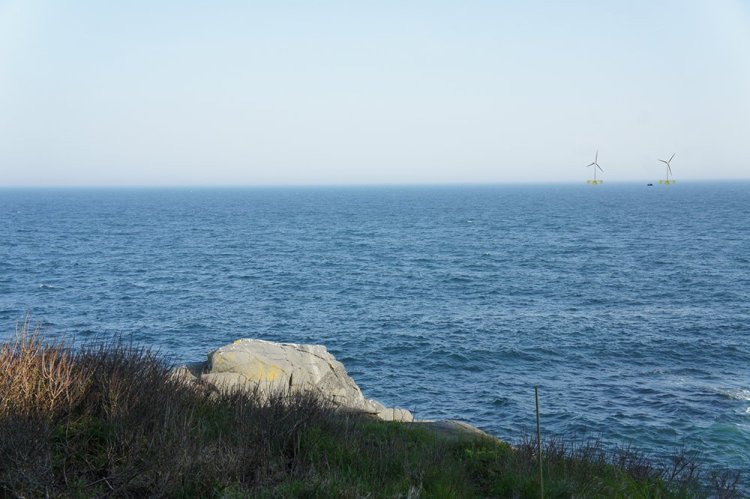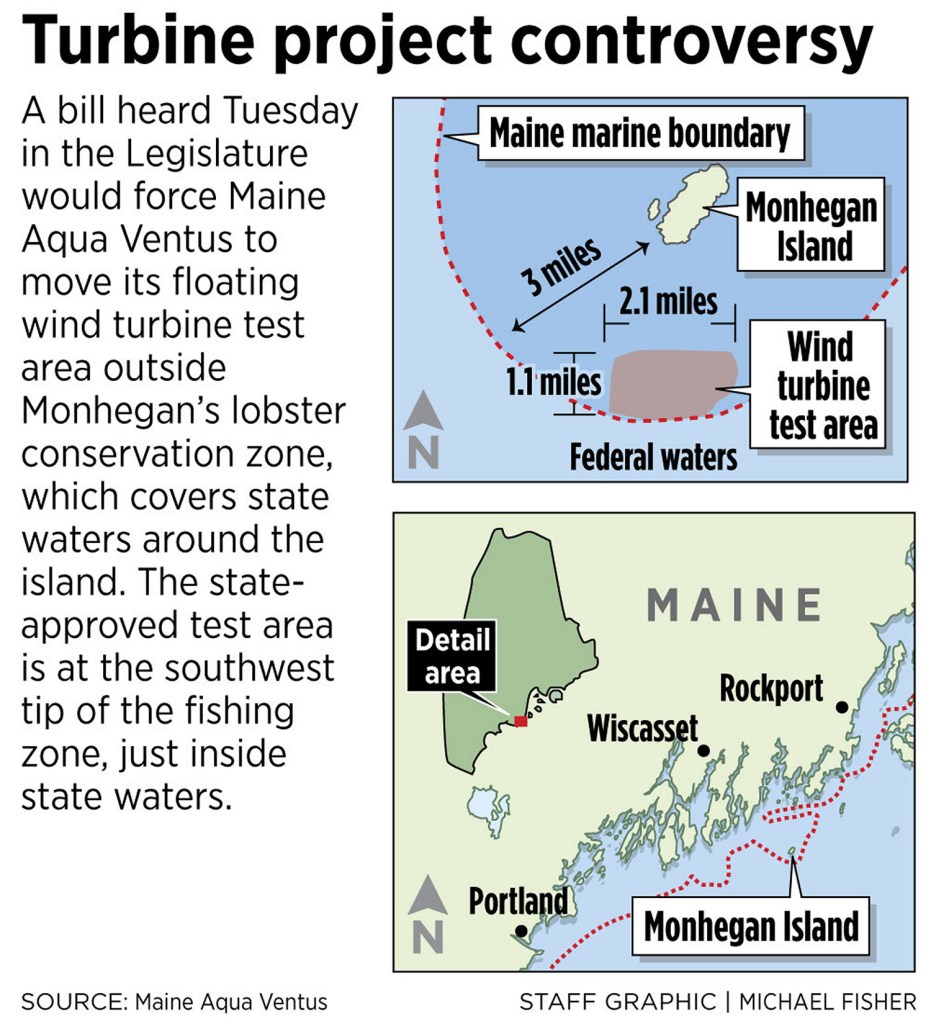AUGUSTA — Lawmakers heard passionate, conflicting testimony Tuesday from dozens of people on a bill aimed at moving a nationally significant wind energy test site farther from Monhegan Island.
Supporters said views of two massive floating turbines would jeopardize tourism, lobster fishing, migrating birds and the sense of serenity associated with Monhegan’s wild beauty. Some said island residents were being bullied and divided by the University of Maine and the partners of Maine Aqua Ventus, a project that is testing new technology for offshore wind turbines about 3 miles from the island. The project initially promised a small, brief test, but has now expanded it beyond anyone’s expectations.
Opponents of the bill, which would move the test site at least 7 miles farther out to sea, said it is unneeded and unwelcome, adding that it would short-circuit the process by which islanders are evaluating the project’s potential benefits. University representatives noted that the site was chosen through a rigorous state process, had survived a court challenge, was endorsed last year by legislative leadership and is still subject to detailed reviews by federal and state agencies. The opponents, who included several island residents, outnumbered supporters at the hearing by a 2-to-1 margin.
Both sides said much is at stake.
Maine Aqua Ventus representatives testified that the bill would have the practical effect of ending Maine’s bid to build the country’s first commercial-size, floating wind turbines and jump-start an industry around offshore, deep-water wind.
But representatives of the Maine Lobstering Union, which represents 500 fishermen, said wind power has no place on the Maine coast. If the industry takes off, undersea cables and moorings associated with offshore wind farms would destroy valuable lobster habitat and imperil fishing. Other lobstermen, though, spoke in favor of the turbines. Mary Weber, whose husband, Matt, fishes around the island, said they didn’t think the turbines would deter tourists, and might even draw a new set of visitors interested in clean energy.
The testimony lasted hours and drew enough interest that two other rooms were set up to handle the overflow crowds at the Energy, Utilities and Technology Committee. In the hall, some people joked about whether anyone was still home on Monhegan, which has a year-round population of roughly 60.
A MATTER OF SCALE
The University of Maine-led venture has spent years surveying wind and wave patterns, marine life and bird migration at a site in state waters, nearly 3 miles southwest of Monhegan. Based in part on the data collected, the project has received $10.7 million from the federal Department of Energy and is eligible for an additional $40 million. If the project can win permits and secure enough public and private money, the Aqua Ventus team hopes to begin testing a pair of floating turbines in 2019.
But L.D. 1262, the bill heard Tuesday, would ban any offshore wind energy project within 10 nautical miles of the Monhegan Lobster Conservation Area. The wind project site is at the southern edge of the lobster zone.
The lobster conservation area earmarked in the bill is roughly 30 square miles and surrounds the island. It was created by state law 20 years ago to set aside an exclusive fishing ground for island residents.
In 2009, the university asked Monhegan lobstermen to map the part of the zone where they did the least amount of fishing. They identified a sector on the southwest tip, along the 3-mile state boundary. That’s where Maine Aqua Ventus established its test site. According to the university, the site now is among the most extensively studied in the Gulf of Maine.
But a spokesman for a group of island residents behind the bill said the university is responsible for the crisis by changing the scope of the project. What started in 2009 as a scaled-down, temporary experiment has grown to a 20-year, full-scale project with blades that would reach 576 feet above the waterline and an undersea cable to the mainland at Port Clyde.
“They want you to believe that we are just jumping in at the last minute to derail their project,” said Travis Dow of Protect Monhegan, the group that wants to move the test turbines. “But the fact is, we have been here from the start. They are the ones who have repeatedly changed the size and scope of the project. They are the ones who have misled and divided our community.”
Supporters of the bill won a welcome ally in Gov. Paul LePage. His acting energy director, Angela Monroe, testified that the high cost of the power contract approved by the Maine Public Utilities Commission would outweigh the benefits for ratepayers.
LePage’s position surprised Rep. Seth Berry, D-Bowdoinham, who co-chairs the energy committee. Berry recalled that LePage held up a landmark energy bill in 2013, forcing the PUC to renegotiate an offshore wind power contract with Statoil, the Norwegian company planning to build a test project off Boothbay. At the time, LePage said he wanted to give Maine Aqua Ventus a better chance to compete. That action prompted Statoil to leave Maine and build its project in Scotland.
Monroe answered that she wasn’t around at the time, but suggested LePage simply wanted the university to be able to participate in competition, which involved a federal grant.
POWER POTENTIAL
The Monhegan conflict is taking shape just as ocean wind power ambitions are ramping up along the East Coast.
The nation’s first offshore wind farm went online last year off Rhode Island. Both New York and Massachusetts are seeking power from big wind ocean farms. These projects would be in shallow water, with turbine towers set in the sea floor using conventional technology used in Europe. Maine Aqua Ventus is pioneering the next generation of wind energy – floating concrete platforms in deep water, far from land, where winds are steady and people can’t see them.
Walt Musial, offshore wind program manager at the National Renewable Energy Laboratory in Golden, Colorado, said that while a few floating platform designs are being tested in other countries, Maine Aqua Ventus is the only one in the United States and is using a technology unique in the world.
“This has the potential to create a whole new industry in the United States,” Musial told the Portland Press Herald in April.
He also has expressed the view that any attempts to relocate the Monhegan test site would doom the project.
“If it moved, it would kill the project,” Musial said. “This is a unique site. If they had to start over, it would set the project back five years and spoil the economics.”
Maine lawmakers will have to decide whether the concerns of roughly half of the year-round Monhegan residents and their supporters outweigh the project’s long-term economic and energy potential. The weight of their decision was alluded to by Sen. Dana Dow, R-Lincoln (no relation to Travis Dow of Protect Monhegan), who sponsored the bill at the request of some island residents.
“I know you’re a committee,” he said. “But for this bill, you’re going to be like a jury.”
The committee will continue its review of the proposal in upcoming work sessions.
The federal Department of Energy plans to decide whether to award Maine Aqua Ventus up to $40 million in final funding early in 2018. To gather public input, federal officials came to Maine in late February and early March for meetings in Tenants Harbor and on Monhegan.
Tux Turkel can be contacted at 791-6462 or at:
tturkel@pressherald.com
Twitter: TuxTurkel
Send questions/comments to the editors.





Comments are no longer available on this story